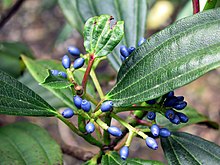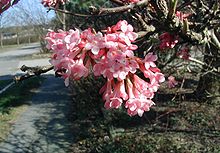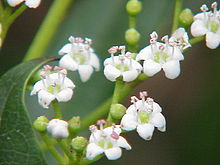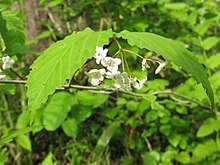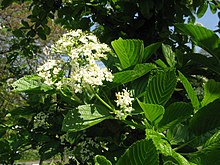Snowball (genus)
| Snowball | ||||||||||||
|---|---|---|---|---|---|---|---|---|---|---|---|---|
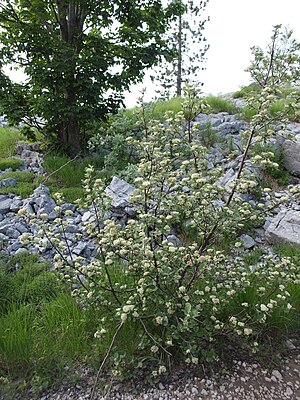
Orjen snowball ( Viburnum maculatum ) |
||||||||||||
| Systematics | ||||||||||||
|
||||||||||||
| Scientific name | ||||||||||||
| Viburnum | ||||||||||||
| L. |
The plant genus viburnum ( Viburnum ) belongs to the family of adoxaceae (Adoxaceae). The 100 to 200 species, depending on the opinion, are mostly distributed in the temperate to subtropical areas of the northern hemisphere . Varieties of some species and hybrids are used as ornamental plants in parks and gardens.
description

Appearance and leaves
In Viburnum TYPES is shrubs or more rarely small trees . There are both evergreen and deciduous species. The bark of the branches is hairy or glabrous; the hairs ( trichomes ) can be simple, bundled, star-shaped or rarely flaky. The winter buds can have bud scales.
The most up constantly , rarely whorled arranged leaves are stalked. They are usually simple, more rarely three- or five-lobed, and have a serrated or smooth leaf margin. There may be small stipules .
Inflorescences and flowers


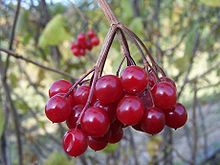
Terminally on the branches or at the ends of short branches with one or two pairs of leaves are in the assembled, cyme or paniculate , zymösen total inflorescence few-flowered dichasia together. The bracts and bracts are usually small and fall off early.
The often fragrant, five-fold flowers are usually radial symmetry and small, but there are also species in which the marginal flowers of the inflorescence are sterile and enlarged, sometimes a little more enlarged outwards so that they are somewhat zygomorphic . In this case, the inflorescences are reminiscent of some hydrangea species, but which usually have four-fold flowers. In the garden form of the "filled snowball" ( Viburnum opulus 'Roseum'), all flowers are sterile and enlarged in ball-shaped inflorescences.
The five sepals are fused into a cylindrical tube that ends in five short calyx lobes. The calyx tube is fused with the ovary. The five mostly white, more rarely pink to reddish or greenish petals are tubular, flat, wheel-shaped, broadly bell-shaped or fused together. There is only one circle with five fertile stamens . The stamens are thread-like and the anthers open with a longitudinal slit. In the half under continuous, three-engine combs ovary , but is only one ovary chamber fertile and that contains only a single ovule . The short style ends in a slightly capped to three-lobed stigma.
fruit
The solitary stone fruits contain a more or less flattened stone core and mostly red or blue "pulp". The stone fruits turn red, purple to black or rarely yellow when ripe.
Use and origin of name
Many snowball species and their hybrids are cultivated in gardens and parks because of their partly fragrant flowers, which in some species also bloom in winter, as well as because of the conspicuous fruits and partly also because of the autumn color of the foliage. A Soviet film from 1974 with the title Kalina Krassnaja (Калина красная) , in the German version "Red Elder", plays with the meaning of this plant in Russian mythology. The reason is probably the heart shape of the fruit kernel. The actually poisonous fruits are traditionally cooked to a good smelling jelly ( Warenje ) as a spread or tea after the first frost .
The common German name snowball has been in use since the 17th century, as the sterile filled snowball with ball-shaped inflorescences ( Viburnum opulus 'Roseum') did not emerge until around 1594.
Systematics and distribution










The genus Viburnum was 1753 by Linnaeus in Species Plantarum , Vol 1, pp 267-268, first published . Type species is Viburnum lantana L.
The genus Viburnum were formerly in the family of Honeysuckle asked (Caprifoliaceae). Like the elder , they have some different characteristics, for example the stone fruits or the lack of nectaries . Recent studies have shown that they belong together with the elderberry genus to the musk herb family (Adoxaceae).
The relationships within the genus, however, remain unclear. (See also Richard C. Winkworth and Michael J. Donoghue, 2005)
Species and their distribution
The genus Viburnum is mostly found in the temperate to subtropical areas of the northern hemisphere . East Asia in particular, but also West Asia, North America , Central America and Europe as well as the Atlas Mountains are part of the distribution area. Some species are found in the Andes of tropical areas. In Central Europe there are only two species, the common snowball and the woolly snowball .
Various sources assign strongly varying numbers of species to the genus Viburnum . Usually, however, between 100 and 200 species are listed. Here is a selection of the types:
- Viburnum acerifolium L .: It is a deciduous shrub with maple-shaped leaves from eastern North America .
- Viburnum amplifolium Rehder : It occurs only in the southern part of the Chinese province of Yunnan .
- Viburnum atrocyaneum C.B.Clarke (Syn .: Viburnum calvum Rehder , Viburnum schneiderianum Hand.-Mazz. ): The home is the north-western Indian continent, in back India Thailand and Myanmar and the southern to western China.
- Viburnum ayavacense H.BK (Syn .: Oreinotinus ayavacensis ( Kunth ) Oerst. ): The home is Ecuador, Peru and Bolivia.
- Viburnum betulifolium Batalin (Syn .: Viburnum adenophorum W.W.Sm. , Viburnum morrisonense Hayata , Viburnum taihasense Hayata , Viburnum willeanum Graebn. , Sometimes be Viburnum dasyanthum Rehder , Viburnum flavescens W.W.Sm. , Viburnum hupehense Rehder , Viburnum lobophyllum Graebn. , Viburnum ovatifolium Rehder and Viburnum wilsonii Rehder assigned to this taxon): The homeland is China and Taiwan.
- Viburnum bitchiuense Makino (istreatedin the "Flora of China" as a variety Viburnum carlesii var. Bitchiuense ( Makino ) Nakai ): The home is Korea , Japan and the Chinese province of Anhui .
- Bodnant viburnum ( Viburnum x bodnantense Aberc. Ex Stearn ). It is a hybrid of Viburnum farreri × Viburnum grandiflorum . It is a shrub that blooms pink in winter and the leaves turn dark red in autumn.
- Viburnum brachyandrum Nakai : This endemic occurs only on the Japanese Izu Islands.
- Viburnum brachybotryum Hemsl. : The home is in the Chinese provinces of Guangxi, Guizhou, Hubei, Hunan, Jiangxi, Sichuan and Yunnan.
- Viburnum bracteatum Rehder (Syn .: Viburnum ozarkense Ashe ): The distribution area is in the US states of Alabama, Arkansas, Georgia, Missouri, Oklahoma and Tennessee.
- Viburnum brevipes Rehder (istreatedas a synonym for Viburnum dilatatum Thunb. In the "Flora of China"): Home is China.
- Viburnum buddleifolium C.H.Wright : It occurs only in the central Chinese province of Hubei.
- Viburnum burejaeticum Regel & Herder (Syn .: Viburnum arcuatum Kom. , Viburnum burejanum Herder , Viburnum davuricum Maxim. ): The distribution ranges from Mongolia through northern and northeastern China and the Far Eastern Russian region of Primorye to North Korea .
- Evergreen scented snowball ( Viburnum × burkwoodii Burkwood & Skipwith , a hybrid of Viburnum carlesii × Viburnum utile ): It is a semi-evergreen shrub that forms clusters of small white flowers in spring and exists only as a cultivated plant. It is also known as the Easter snowball.
- Viburnum × carlcephalum Burkwood ex RBPike , a hybrid of Viburnum carlesii × Viburnum macrocephalum : It only exists as a cultivated plant.
- Korean snowball ( Viburnum carlesii Hemsl. ), A small, deciduous shrub from Korea and the Japanese islands of Honshu, Kyushu and Shikoku with tapering leaves and a finely serrated leaf margin.
- Viburnum cassinoides L .: The distribution area is in eastern Canada and in eastern to central states of the USA.
- Viburnum chingii P.S.Hsu : It is found in the southern Chinese provinces of Sichuan and Yunnan and in northern Myanmar.
- Viburnum chinshanense Graebn. (Syn .: Viburnum cavaleriei H.Lév. , Viburnum hypoleucum Rehder , Viburnum rosthornii Graebn. ): The home is the Chinese provinces of Chongqing, Gansu, Guizhou, Shaanxi, Sichuan and Yunnan.
- Viburnum chunii P.S.Hsu : Distribution area are the Chinese provinces of Anhui, Fujian, Guangdong, Guangxi, Guizhou, Hunan, Jiangxi, Sichuan and Zhejiang.
- Viburnum cinnamomifolium Rehder : This large, evergreen shrub has inflorescences up to 15 centimeters wide. The home is in the southwest Chinese provinces of Sichuan and Yunnan.
- Viburnum colebrookeanum Wall. ex DC. : The distribution area includes the southern Chinese island of Hainan, northern Myanmar and the Himalayan region with northern India, Bhutan and Nepal.
- Viburnum congestum Rehder (Syn .: Hedyotis mairei H.Lév. , Oldenlandia mairei ( H.Lév. ) Chun , Premna esquirolii H.Lév. , Viburnum mairei H.Lév. ): The distribution area is in the Chinese provinces of Gansu, Guizhou, Sichuan and Yunnan.
- Viburnum corylifolium Hook.f. & Thomson (Syn .: Viburnum barbigerum H.Lév. , Viburnum dunnianum H.Lév. ): Home is the northern Indian state of Assam and the Chinese provinces or autonomous regions of Guangxi, Guizhou, Hubei, Shaanxi, Sichuan, Yunnan and Tibet.
- Viburnum corymbiflorum P.S.Hsu & SCHsu : Home is about the southern half of China.
- Viburnum cotinifolium D.Don (Syn .: Viburnum multratum K.Koch , Viburnum polycarpum Wall. Ex DC. ): The occurrences range from Afghanistan via Pakistan, Kashmir, northern India and Nepal to Bhutan and southern Tibet.
- Viburnum cylindricum Buch.-Ham. ex D.Don (Syn .: Viburnum capitellatum Wight & Arn. , Viburnum coriaceum Blume , Viburnum crassifolium Rehder ): The distribution extends from southern to western China, the Indian subcontinent with Bhutan, Nepal, Pakistan, India and Sri Lanka via back India with Vietnam, Myanmar and Thailand to Malaysia and Indonesia.
- Viburnum dalzielii W.W.Sm. : The homeland are the southeastern Chinese provinces of Guangdong and Jiangxi.
- Viburnum dasyanthum Rehder (is sometimes used as a synonym for Viburnum betulifolium Batalin ): The distribution area is in central China.
- Viburnum davidii Franch. , a small but broad-growing, evergreen shrub from the Chinese province of Sichuan.
- Viburnum dentatum L. (Syn .: Viburnum ashei Bush , Viburnum pubescens ( Aiton ) Pursh , Viburnum recognitum Fernald , Viburnum scabrellum ( Torr. & A. Gray ) Chapm. , Viburnum semitomentosum ( Michx. ) Rehder and Viburnum venosum Britton ): Er is a deciduous shrub with broad, toothed leaves from eastern Canada and eastern to central states of the United States .
- Viburnum dilatatum Thunb. (Syn .: Viburnum brevipes Rehder , Viburnum fulvotomentosum P.S.Hsu ): The home is China, Taiwan, Korea and Japan.
- Viburnum edule ( Michx. ) Raf. (Syn .: Viburnum pauciflorum Bach.Pyl. Ex Torr. & A.Gray ): The distribution area extends in North America from the US-American Alaska via Canada to the northern states of the USA.
- Viburnum erosum Thunb. (Syn .: Viburnum ichangense ( Hemsl. ) Rehder , Viburnum matsudae Hayata , Viburnum villosifolium Hayata , Viburnum meyer-waldeckii Loes. , Viburnum taquetii H.Lév. ): The distribution area extends from China via Korea to Japan and Taiwan.
- Viburnum erubescens Wall. ex DC. (Syn .: Solenotinus erubescens ( Wall. ) Oerst. , Viburnum botryoideum H.Lév. , Viburnum burmanicum ( Rehder ) CYWu ex PSHsu , Viburnum prattii Graebn. , Viburnum pubigerum Wight & Arn. , Viburnum thibeticum C.Y.Wu & YFHuang , Viburnum wightianum Wall. ): The deposits are in the Chinese provinces of Gansu, Guangxi, Guizhou, Hubei, Shaanxi, Sichuan, Xizang and Yunnan as well as in northern Myanmar, Bhutan, the Indian Himalayan region and Nepal.
- Viburnum farreri Stearn (Syn. Viburnum fragrans Bunge , Lonicera mongolica J.F. Gmel. ): It is a deciduous shrub with widely spreading branches, whose delicate pink to white flowers smell pleasant. It is home to the northwest Chinese provinces of Gansu, Qinghai and the Chinese autonomous region of Xinjiang.
- Viburnum flavescens W.W.Sm. (used by the "Flora of China" as a synonym for Viburnum betulifolium Batalin ): Home is China.
- Viburnum foetens Decne. (The "Flora of Pakistan" sees this species as a synonym of Viburnum grandiflorum Wall. ex DC. ): The range is in Afghanistan and Pakistan.
- Viburnum foetidum Wall. (Syn .: Hedyotis yunnanensis H.Lév. , Oldenlandia yunnanensis ( H.Lév. ) Chun , Premna valbrayi H.Lév. , Viburnum ajugifolium H.Lév. , Viburnum ceanothoides C.H.Wright , Viburnum pallidum Franch. , Viburnum parvilimbum Merr. , Viburnum premnaceum Wall. Ex DC. , Viburnum rectangulare Graebn. Ex Hayata , Viburnum rectangulatum Graebn. , Viburnum touchanense H.Lév. ): The occurrences range from China via Laos, Myanmar and Thailand to Bangladesh, Bhutan and north-eastern India.
- Viburnum fordiae Hance (Syn .: Viburnum hirtulum Rehder ): The occurrences are in the southern Chinese provinces of Anhui, Fujian, Guangdong, Guangxi, Guizhou, Hunan, Jiangxi, Yunnan and Zhejiang.
- Viburnum formosanum ( Hance ) Hayata (Syn .: Viburnum subglabrum Hayata ): The home is the Chinese provinces of Fujian, Guangdong, Guangxi, Hunan, Jiangxi, Sichuan, Zhejiang and Taiwan.
- Viburnum furcatum flower ex Maxim. : Distribution areas are Sakhalin and the Kuril Islands in Far Eastern Russia and Japan.
- Viburnum glabratum Kunth : The homeland is the Andes in Colombia.
- Viburnum glomeratum Maxim. (Syn .: Viburnum veitchii C.H.Wright ): Home is China and northern Myanmar.
- Viburnum grandiflorum Wall. ex DC. : The natural range is southern Tibet, Bhutan, the Indian state of Sikkim, Nepal, the Kashmir region and Pakistan.
- Viburnum hainanense Merr. & Chun (Syn .: Viburnum tsangii Rehder ): The home is the southern Chinese provinces of Guangdong and Guangxi, Hainan and Vietnam.
- Viburnum hanceanum Maxim. : The home is the southern Chinese provinces of Fujian, Guangdong, Guangxi, possibly Guizhou, Hunan and Jiangxi.
- Viburnum harryanum Rehder : Home is western China.
- Viburnum hengshanicum Tsiang ex PSHsu : The distribution area is the Chinese provinces of Anhui, Guangxi, Guizhou, Hunan, Jiangxi and Zhejiang.
- Viburnum henryi Hemsl. : The homeland are the Chinese provinces of Fujian, Guangxi, Guizhou, Hubei, Jiangxi, Shaanxi, Sichuan and Zhejiang.
- Viburnum × hillieri Stearn (a hybrid of Viburnum erubescens × Viburnum henryi )
- Viburnum hupehense Rehder (is synonymous with Viburnum betulifolium Batalin in the "Flora of China"): Home is central China.
- Viburnum ichangense ( Hemsl. ) Rehder (is in the "Flora of China" as a synonym for Viburnum erosum var. Erosum Batalin ): Home is the central and southwestern China.
- Viburnum incarum Graebn. : Home is Peru and Ecuador.
- Viburnum inopinatum Craib : The distribution extends from the southern Chinese provinces of Guangxi and Yunnan to rear India with northern Vietnam, Laos, Myanmar and Thailand.
- Viburnum integrifolium Hayata : Home is Taiwan.
- Viburnum japonicum ( Thunb. ) Spreng. : (Syn .: Cornus japonica Thunb. , Viburnum boninsimense ( Makino ) Koidz. Ex Nakai , Viburnum fusiforme Nakai ): Home is Japan and Taiwan.
- Viburnum × juddii Rehder , parents are Viburnum bitchiuense × Viburnum carlesii : This hybrid only exists as a cultivated plant.
- Viburnum kansuense Batalin : The distribution area are the Chinese provinces of Gansu, Shaanxi, Sichuan, Yunnan and Tibet.
- Viburnum koreanum Nakai (Syn .: Viburnum coreanum Nakai , orth. Var.): The home is the Chinese Manchuria, Korea and Japan.
- Viburnum lancifolium P.S.Hsu : Home to the Chinese provinces of Fujian, Jiangxi, Zhejiang and possibly Guangdong.
- Woolly snowball ( Viburnum lantana L. ), a deciduous shrub from Europe and Western Asia with characteristic, very hairy young shoots.
- Viburnum lantanoides Michx. (Syn .: Viburnum alnifolium auct.): The natural distribution area is eastern Canada and the north and south-east USA.
- Viburnum laterale Rehder : It occurs only in the Chinese province of Fujian .
- Viburnum leiocarpum P.S.Hsu : Home is the southern provinces of Yunnan and Hainan in China.
- Canadian snowball ( Viburnum lentago L. ): The distribution is in Canada and the USA.
- Viburnum lobophyllum Graebn. (in the "Flora of China" is used as a synonym for Viburnum betulifolium Batalin ): Home is China.
- Viburnum longipedunculatum ( PSHsu ) PSHsu : The distribution area is in the southern Chinese provinces of Guangxi and Yunnan.
- Viburnum longiradiatum P.S.Hsu & SWFan : The occurrences are in the Chinese provinces of Sichuan and Yunnan.
- Viburnum lutescens flower (Syn .: Viburnum monogynum flower , Viburnum sundaicum Miq. ): The distribution area extends from southern China through India, Vietnam, Myanmar and Malaysia to Indonesia.
- Viburnum Luzonicum Rolfe (Syn .: Viburnum foochowense W.W.Sm. , Viburnum mushanense Hayata , Viburnum parvifolium W.W.Sm. , Viburnum smithianum H.L.Li , Viburnum smithii F.P.Metcalf ): The deposits are located in southern China, Taiwan, Malaysia, the Philippines and possibly in Indonesia.
- Viburnum macrocephalum Fortune (Syn .: Viburnum keteleeri Carrière ) with large sterile marginal flowers; the natural occurrences are in the eastern provinces of Anhui, Henan, Hubei, Hunan, Jiangsu, Jiangxi, Shandong and Zhejiang in China.
- Orjen snowball ( Viburnum maculatum Pant. ): It occurs in Albania and Bosnia-Herzegovina.
- Viburnum mathewsii ( Oerst. ) Killip & ACSm. (Syn .: Oreinotinus mathewsii Oerst. , Viburnum fur Graebn. ): The homeland is Ecuador and Peru.
- Viburnum melanocarpum P.S.Hsu : The homeland is the east Chinese provinces of Anhui, Henan, Jiangsu, Jiangxi and Zhejiang.
- Viburnum molle Michx. : The original range are eastern to central states of the USA.
- Viburnum mongolicum ( Pall. ) Rehder (Syn .: Lonicera mongolica Pall. , Viburnum davuricum Pallas ): The distribution area extends from eastern Russia via Mongolia to northern to central China.
- Viburnum mullaha Buch.-Ham ex D.Don (Syn .: Viburnum involucratum Wall. Ex DC. , Viburnum stellulatum Wall. Ex DC. , Viburnum thaiyongense W.W.Sm. ): The home is in the Chinese province of Yunnan or in the autonomous region Tibet, in back India and in the Himalayan region with Bhutan, in the Indian state of Assam, in Nepal, the region of Kashmir and Pakistan.
- Viburnum nervosum D.Don (Syn .: Solenotinus nervosus ( D.Don ) Oerst. , Viburnum cordifolium Wall. Ex DC. ): The distribution area includes the Chinese provinces of Guangxi, Hunan, Sichuan, Xizang and Yunnan, as well as northern Vietnam and northern Myanmar and the Himalaya region with Bhutan, the Indian state of Assam and Nepal.
- Viburnum nudum L. (Syn .: Viburnum nitidum Aiton ): The occurrences are in the eastern states of the USA and in Texas.
- Viburnum obovatum Walter : The home is in the southeast of the USA in the states of South Carolina, Georgia, Florida and Alabama.
- Viburnum odoratissimum Ker Gawl. (Syn .: Microtinus odoratissimus Ker Gawl. ) Oerst. , Thyrsosma chinensis Raf. , nom. illegal. Superfl., Viburnum arboricola Hayata , Viburnum awabuki K.Koch , Viburnum kerrii Geddes , Viburnum sessiliflorum Geddes , Viburnum simonsii J.D.Hooker & Thomson , Viburnum sinense Zeyh. ex Colla , Viburnum sphaerocarpum Y.C. Liu & CHOu. : It is an evergreen species, the natural range of which stretches from southern China, Japan and Taiwan via back India and the Philippines to the Himalayas in the northeast Indian state of Assam. It forms shrubs or small trees and has very fragrant, white flowers.
- Viburnum oliganthum Batalin (Syn .: Viburnum stapfianum H.Lév. ): Home to the Chinese provinces of Guizhou, Hubei, Sichuan, Yunnan and the Tibet Autonomous Region.
- Viburnum omeiense P.S.Hsu : Home is the Chinese province of Sichuan.
- Snowball ( Viburnum opulus L. ), a very common shrub from Europe, Asia and North America. There are three varieties.
- Viburnum orientale Pall. : The homeland is Turkey, Azerbaijan and Georgia.
- Viburnum ovatifolium Rehder (The "Flora of China" uses this taxon as a synonym for Viburnum betulifolium Batalin ): Home is China.
- Viburnum parvifolium Hayata (Syn .: Viburnum yamadae Bartlett & Yamam. ): The home is Taiwan.
- Viburnum phlebotrichum sieve. & Zucc. : The home is Japan.
- Viburnum pichinchense Benth. : Homeland is Colombia, Ecuador and Bolivia.
- Japan snowball ( Viburnum plicatum Thunb. , Syn .: Viburnum tomentosum Thunb. ): It is a deciduous shrub whose leaves are folded like the hazelnut . The natural occurrence ranges from China to Taiwan and Japan to Korea.
- Viburnum propinquum Hemsl. : The distribution area is in China, Taiwan and the Philippines.
- Plum-leaved viburnum ( Viburnum prunifolium L. ): The distribution area is in eastern to central states of the USA.
- Viburnum punctatum Buch.-Ham. (Syn .: Viburnum acuminatum Wall. Ex DC. , Viburnum lepidotulum Merr. & Chun ): The occurrences extend from southern China via rear India to Indonesia and from Thailand via Bhutan to Nepal.
- Viburnum pyramidatum Rehder : The home is the southern Chinese provinces of Guangxi and Yunnan as well as northern Vietnam.
- Viburnum rafinesqueanum Schult. : The distribution area is in Canada and the USA.
- Viburnum reticulatum Ruiz & Pav. (Syn .: Oreinotinus reticulatus Ruiz & > Pav. Ex Oerst. , Viburnum weberbaueri Graebn. ): Home is Ecuador and Peru.
- Viburnum × rhytidocarpum Lemoine (a hybrid of Viburnum buddleifolium × Viburnum rhytidophyllum ): It may only exist as a cultivated plant.
- Viburnum × rhytidophylloides J.V.Suringar (a hybrid of Viburnum lantana × Viburnum rhytidophyllum ): This hybrid may only exist as a crop.
- Wrinkled-leaf viburnum ( Viburnum rhytidophyllum Hemsl. ), A large, evergreen shrub with very wrinkled, large leaves that are gray to brown tomentose on the underside. His home is China.
- Viburnum rigidum Vent. : It only occurs in the Canaries. Some authors also call it the subspecies Viburnum tinus subsp. rigidum (Vent.) P. Silva placed next to Viburnum tinus .
- Viburnum rufidulum Raf. : The home is the USA.
- Viburnum schensianum Maxim. (Syn .: Viburnum dielsii Graebn. , Viburnum giraldii Graebn. ): The distribution areas are in the Chinese provinces of Anhui, Gansu, Hebei, Henan, Hubei, Jiangsu, Shaanxi, Shandong, Shanxi, Sichuan and Zhejiang.
- Viburnum sempervirens K.Koch (Syn .: Viburnum nervosum Hook. & Arn. , Viburnum pinfaense H.Lév. , Viburnum venulosum Benth. ): Home is southeast to central China.
- Viburnum setigerum Hance (Syn .: Viburnum bodinieri H.Lév. , Viburnum theiferum Rehder ): The natural distribution is about the southern half of China and Taiwan.
- Viburnum shweliense W.W.Sm. : The home is in western Yunnan and possibly in Myanmar.
- Viburnum Sieboldii Miq. : The home is Japan.
- Viburnum squamulosum P.S.Hsu : The home is the Guangxi Autonomous Region in southern China.
- Viburnum subalpinum Hand.-Mazz. : The homeland is the southern province of Yunnan in China and the north of Myanmar.
- Viburnum suspensum Lindl. : This endemic occurs only on the Japanese Ryūkyū Islands .
- Viburnum sympodiale Graebn. (Syn .: Viburnum martini H.Lév. , Viburnum melanophyllum Hayata ): The home is China and Taiwan.
- Viburnum taitoense Hayata (Syn .: Viburnum tubulosum P.S.Hsu ): Home is Taiwan and the Autonomous Region of Guangxi and the Chinese Province of Hunan.
- Viburnum tengyuehense ( WWSm. ) PSHsu (Syn .: Viburnum oblongum P.S.Hsu ): The range is in the southwestern provinces of Guizhou and Yunnan and possibly Myanmar.
- Viburnum ternatum Rehder (Syn .: Viburnum chaffanjonii H.Lév. ): The occurrences are in the Chinese provinces of Guizhou, Hubei, Hunan, Sichuan and Yunnan.
- Mediterranean viburnum , laurel-leaved viburnum ( Viburnum tinus L. ), an often cultivated, evergreen shrub from the scrub vegetation of the Mediterranean region . One can distinguish three subspecies. One of them occurs in the Canaries and the Azores.
- Viburnum trabeculosum C.Y.Wu ex PSHsu : It is native to the south of the Chinese province of Yunnan .
- American snowball , cranberry bush ( Viburnum trilobum Marshall : Used by some authors as a subspecies or variety of ordinary snowball ( Viburnum opulus subsp. Americanum (Mill) Piper & Beattie. Or Viburnum opulus var. Americanum Aiton viewed))
- Viburnum triphyllum Benth. (Syn .: Oreinotinus laurifolius Oerst. , Oreinotinus triphyllus Oerst. ): Home is Colombia, Ecuador and Peru.
- Viburnum triplinerve Handel-Mazz. (Possibly identical to Viburnum propinquum Hemsl. ): Home is the Guangxi Autonomous Region in southern China.
- Viburnum urbani Graebn. : The home is Colombia and Ecuador.
- Viburnum urceolatum sieve. & Zucc. (Syn .: Viburnum taiwanianum Hayata ): The distribution ranges from China via Taiwan to Japan.
- Useful Snowball ( Viburnum utile Hemsl. ): It is home to the provinces of Guizhou , Henan , Hubei , Hunan , Shaanxi and Sichuan in central China.
- Viburnum veitchii C.H.Wright (is considered in the "Flora of China" as a synonym of Viburnum glomeratum subsp. Glomeratum ): Home is central China.
- Viburnum × vetteri Zabel , a hybrid of Viburnum lentago × Viburnum nudum
- Viburnum villosum Sw. : The home is the Caribbean islands of Cuba and Jamaica .
- Viburnum wilsonii Rehder (in the "Flora of China" is a synonym for Viburnum betulifolium Batalin ): The home is western China.
- Viburnum wrightii Miq. (Syn .: Viburnum hessei Koehne ): The home is Japan, Korea and northeastern Russia.
- Viburnum yunnanense Rehder : Home is the province of Yunnan in southwest China.
See also
literature
- Qiner Yang, Valéry Malécot: Adoxaceae In Wu Zheng-yi, Peter H. Raven, Deyuan Hong (Eds.): Flora of China . Volume 19: Cucurbitaceae through Valerianaceae, with Annonaceae and Berberidaceae . Science Press / Missouri Botanical Garden Press, Beijing / St. Louis 2011, ISBN 978-1-935641-04-9 , pp. 570 (English). Viburnum Online (section description, distribution and systematics - text identical to the printed work)
- Rubina Akhter: Caprifoliaceae . In: SIAli & M.Qaiser (eds.): Flora of Pakistan . tape 174 . University of Karachi et al. Missouri Botanical Garden (St. Louis), Karachi u. St. Louis 1986, OCLC 180586559 , Viburnum , p. 5 ( online date January 1, 2001 text identical to the printed work - section description and systematics).
- Siegfried Danert et al: Flowering Plants 2 . 1st edition. tape 4 . Urania-Verlag, Leipzig 1994, ISBN 3-332-00497-2 .
Individual evidence
- ↑ Dericks-Tan, Vollbrecht: On the trail of wild fruits in Europe . Abadi-Verlag, 2009, ISBN 978-3-00-021129-4 , pp. 258 .
- ↑ Carl von Linné: Species Plantarum . tape 1 . Stockholm 1753, p. 267–268 (first online publication of Viburnum scanned at Botanicus Digital Library ).
- ↑ Richard C. Winkworth and Michael J. Donoghue: Viburnum phylogeny based on combined molecular data: implications for taxonomy and biogeography . In: Botanical Society of America, Inc. (Ed.): American Journal of Botany . tape 92 , no. 4 , April 1, 2005, ISSN 0002-9122 , p. 653–666 , doi : 10.3732 / ajb.92.4.653 (and full version online ).
- ↑ a b c d e f g h Carmen Ulloa Ulloa, Peter Møller Jørgensen: Trees and shrubs of the Andes of Ecuador (Árboles y arbustos de los Andes del Ecuador) . Caprifoliaceae. Aarhus University Press u. a., Risskov et al. a. 1993, ISBN 978-87-87600-39-2 , Viburnum ( online - same text with printed work).
- ^ Viburnum at Tropicos.org. In: Flora de Nicaragua . Missouri Botanical Garden, St. Louis
- ↑ a b c d e f g h i j k l m n o p q r s t u v w x y z aa ab ac ad ae af ag ah ai aj ak al am an ao ap aq ar as at au av aw ax ay az ba bb bc bd be bf bg bh bi bj bk Viburnum in the Germplasm Resources Information Network (GRIN), USDA , ARS , National Genetic Resources Program. National Germplasm Resources Laboratory, Beltsville, Maryland. Retrieved April 6, 2012.
- ↑ Viburnum ayavacense. In: Tropicos. Missouri Botanical Garden, accessed April 1, 2012 (English, see synonyms and spreads).
- ↑ a b c d e f g h i j k l m Yang Kuoh-Chen, Chiu Shau-Ting: Caprifoliaceae . In: Editorial Committee of the Flora of Taiwan (Ed.): Plants of Taiwan . Flora of Taiwan - Angiosperms, Dicotyledons [Diapensiaceae - Compositae]. 2nd Edition. tape 4 . Editorial Committee of the Flora of Taiwan, Taipei 1998, ISBN 957-02-3121-1 , Viburnum , pp. 750 ff . ( Online - the same text as the printed work).
- ^ E. von Raab-Straube (2017+): Viburnaceae. Datasheet Viburnum In: Euro + Med Plantbase - the information resource for Euro-Mediterranean plant diversity .
- ↑ Viburnum mathewsii. In: Tropicos. Missouri Botanical Garden, accessed April 3, 2012 (English, see Synonyms and Spreads).
- ↑ Viburnum pichinchense. In: Tropicos. Missouri Botanical Garden, accessed April 3, 2012 .
- ↑ Viburnum reticulatum. In: Tropicos. Missouri Botanical Garden, accessed April 3, 2012 (English, see Synonyms and Spreads).
- ↑ Viburnum triphyllum. In: Tropicos. Missouri Botanical Garden, accessed April 3, 2012 (English, see Synonyms and Spreads).
- ↑ Viburnum urbanii. In: Tropicos. Missouri Botanical Garden, accessed April 3, 2012 .
Web links
- Carmen Ulloa Ulloa, Peter Møller Jørgensen: Trees and shrubs of the Andes of Ecuador (Árboles y arbustos de los Andes del Ecuador) . Caprifoliaceae. Aarhus University Press u. a., Risskov et al. a. 1993, ISBN 978-87-87600-39-2 , Viburnum ( online - same text with printed work).




